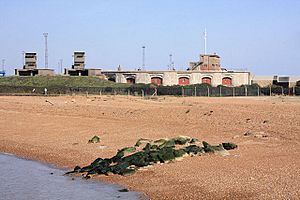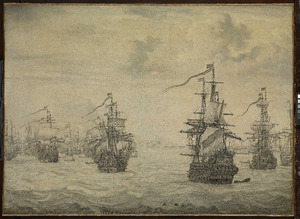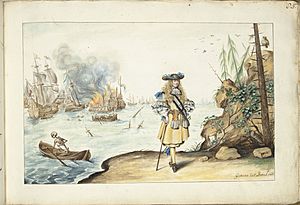Battle of Landguard Fort facts for kids
Quick facts for kids Battle of Landguard Fort |
|||||||
|---|---|---|---|---|---|---|---|
| Part of the Second Anglo-Dutch War | |||||||
 Present-day Landguard Fort. The Dutch attacked this side of the fort. |
|||||||
|
|||||||
| Belligerents | |||||||
| Commanders and leaders | |||||||
| Thomas Dolman Michiel de Ruyter Willem Joseph van Ghent |
Nathaniel Darrell James Howard |
||||||
| Strength | |||||||
| 1,500 marines and 500 sailors | 450 militia and marines 500 infantry (arrived late in battle) 1 galliot |
||||||
| Casualties and losses | |||||||
| 150 killed, wounded or captured | 10 casualties | ||||||
The Battle of Landguard Fort was an important fight during the Second Anglo-Dutch War. It happened on July 2, 1667. Dutch forces tried to attack Landguard Fort near Felixstowe, England. Their goal was to clear the way for a bigger attack on the English naval base at Harwich.
However, the Dutch attack, led by Admiral Michiel de Ruyter, was stopped. Because of this, the planned attack on Harwich was called off. This battle was one of the last major fights in Europe before the Treaty of Breda was signed, ending the war.
Contents
Why Did the Battle Happen?
After a big Dutch victory at the Medway in June 1667, the Dutch navy controlled the Thames Estuary. This meant they could block ships from entering or leaving London. But other attempts to operate in the Thames area were not as successful.
So, in early July, Admiral de Ruyter decided to attack Harwich. Harwich was an important English naval base and a safe place for ships.
Protecting Harwich: Landguard Fort
Before attacking Harwich, the Dutch needed to deal with Landguard Fort. This fort was the main defense for the port. Landguard Fort sits on a narrow strip of land that stretches south from Felixstowe. It guards the entrance to the River Stour and River Orwell rivers. Harwich is on the other side of the river mouth.
The fort was defended by about 400 skilled soldiers from the Duke of York and Albany's Maritime Regiment. This group was an early version of the Royal Marines. The fort also had 40 cannons and about 100 gun crew members. Nathaniel Darrell was the governor of Landguard Fort.
The Battle Begins
Admiral de Ruyter planned to attack the fort from two sides. One group of ships would go inside the river mouth, and another would stay out at sea. But the water inside the estuary was too shallow. This meant the attack from that side had to be canceled. The ships out at sea could only fire a few shots from far away.
Despite this, de Ruyter decided to continue the attack. The Dutch sent their marines and sailors ashore in small boats. About 1,500 marines and 500 sailors landed north of the fort at Cobbold's Point. This spot was too far for the fort's cannons to reach them.
Dutch Attack on the Fort
The Dutch forces had to split up. Most of the sailors stayed at the landing point. The marines marched south to attack the fort. They had a tough job dragging their heavy cannons across the shingle beach, which is made of small, loose stones.
The English defenders at the fort were ready. They had been warned that a Dutch attack might happen after the defeat at Medway. The Dutch marines quickly launched their first attack. They brought ladders to try and climb the fort walls. But the English fired back with strong, focused shots. After about 45 minutes, the Dutch were forced back, having lost some men.
Second Attack and Retreat
The Dutch did not give up. They regrouped and launched a second attack. This time, a small English ship called a galliot joined the fight. It fired grapeshot at the Dutch soldiers on the beach. Grapeshot is like a shotgun blast, and it sprayed the shingle on the beach. This made the shingle act like shrapnel, hurting many Dutch soldiers.
During this second attack, the Dutch commander, Colonel Thomas Dolman, was killed. This caused confusion among the Dutch marines. Less than 15 minutes later, the leaderless Dutch soldiers retreated. They left their ladders and other equipment behind. The English captured some prisoners, and the Dutch suffered many casualties. The Dutch ships out at sea could only fire a few ineffective shots.
Fighting on the Beach
While the marines were attacking the fort, the Dutch sailors at the beachhead were attacked by local English militia. These militia were led by the Earl of Suffolk. The English kept firing until 10:00 PM. The sailors, with many injured and unable to move forward, decided to retreat.
By this time, the low tide trapped the Dutch on shore until about 2:00 AM the next day. This gave 500 English soldiers, led by Major Legge, time to arrive from Harwich. These new English troops had some small fights with the retreating Dutch. No English cavalry arrived, but Legge's men were soon outnumbered when the defeated Dutch marines joined the sailors on the beach. No major fighting happened then. The Dutch were able to get back on their ships after 2:00 AM. By 6:00 AM, their entire fleet had sailed away from Harwich.
What Happened Next?
The Dutch had moderate losses, with fewer than 150 men killed, wounded, or captured. The English lost only about 10 men. However, Governor Darrell was wounded in the shoulder by a musket ball.
After this failed attack, the Dutch continued to block the Thames River. Admiral de Ruyter then sailed to patrol the English Channel. He left Admiral Jan Jansse van Nes in charge of the blockade, which lasted until the end of July.
The fighting finally ended when the Peace of Breda was signed on July 31, 1667.
A Lasting Impact
The Battle of Landguard Fort is important because it was an early battle honor for both English and Dutch marines. The Dutch Regiment de Marine was formed by Michiel de Ruyter in 1665. They had won their first battle honor at Chatham during the Medway raid earlier that year. This group later became the Netherlands Marine Corps.
The soldiers defending Landguard Fort were from the Duke of York and Albany's Maritime Regiment. This group was formed in 1664 and was one of the first groups that led to the creation of the Royal Marines. The defense of Landguard Fort was their first battle honor. It is also remembered as the site of the last time England was invaded or attacked by an enemy force.
Today, Landguard Fort still stands and is open for people to visit.



